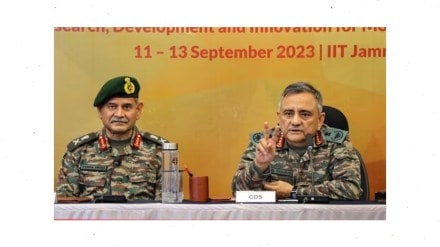The Indian military is embarking on a transformative journey to adapt to the evolving landscape of warfare, as highlighted by Chief of Defence Staff (CDS) General Anil Chauhan and Army Chief General Upendra Dwivedi. Key initiatives, including the launch of a pioneering future warfare course and the development of joint theatre commands, underscore India’s proactive stance in addressing contemporary security challenges.
Future Warfare Course: A Breakthrough in Military Education
At the Bharat Shakti Defence Conclave in New Delhi, General Chauhan announced that the inaugural future warfare course is set to begin on September 23, 2024. This innovative program deviates from traditional military education by being “rank-agnostic,” allowing officers from various ranks, including Majors and Major Generals, to learn together. “It’s breaking barriers,” the CDS emphasized, highlighting the importance of cross-rank learning. In this unique environment, “a major general may probably learn something from a major, and a major can learn strategy and operations from a major general,” he noted.
The course aims to equip officers with the necessary skills to navigate future conflicts, focusing on India’s distinctive approach rather than merely imitating advanced military practices. “We are going to say how we are going to fight in the future and how we will lay the roadmap,” General Chauhan explained, showcasing India’s commitment to developing home grown strategies.
Joint Theatre Commands: A Strategic Evolution
A significant focus of the military’s future planning involves the establishment of joint theatre commands, which aim to streamline operations across the Army, Navy, and Air Force. General Chauhan outlined the broader contours of this initiative, which seeks to enhance operational efficiency and improve response times in crises. By integrating resources and capabilities, the theatre commands are designed to foster a more cohesive and agile military structure.
The CDS highlighted the necessity of this integration in light of evolving warfare dynamics, stating, “We discussed how warfare is evolving and what we need to do about it.” The move towards joint theatre commands reflects an understanding that modern conflicts require a collaborative approach, leveraging the strengths of different military branches.
Strategic Rebalancing: Lessons from the Ladakh Standoff
In light of ongoing tensions with China, General Dwivedi discussed at the Conclave the Indian Army’s approach to the border situation, particularly since the standoff in May 2020. He acknowledged the necessity of reassessing military readiness and strategy, stating, “After April or May 2020, we had to think about if there is a case of rebalancing.” This ongoing effort has entered what he termed “Rebalancing 2.0,” indicating a more comprehensive strategic overhaul.
General Dwivedi stressed the importance of psychological readiness alongside logistical and operational adjustments. “There has to be a psychological orientation,” he asserted, underscoring the need for the military to ensure that equipment and training are attuned to current operational requirements. The rebalancing process is also referred to as “Rebalancing 1.5,” reflecting ongoing adaptations in training and command structures.
Infrastructure and Northern Front Preparedness
The Army Chief placed significant emphasis on enhancing infrastructure along the northern border. “The infrastructure along the northern front is something that needs major attention,” he stated, recognizing the critical need for robust development in this strategically sensitive area. He affirmed that national priorities are increasingly focused on bolstering border infrastructure.
Reflecting on lessons learned from past confrontations, particularly the Galwan Valley clash, General Dwivedi noted the existence of “grey zone” conflicts prior to April 2020. While the Indian Army was aware of these dynamics, he acknowledged that previous incidents, such as the Doklam standoff, prompted a reassessment of preparedness. “Were we prepared for it? Yes, we were generally aware of it, but it was Doklam which made us awake,” he explained.
Integration and Jointness in India’s Armed Forces
Both leaders discussed the importance of achieving greater integration and jointness within the Indian armed forces. General Dwivedi highlighted ongoing efforts to create joint training institutes and logistics systems, stating that these initiatives are gaining momentum. “Since the present CDS has taken over, speed [on the process] has gone up to three times than what was earlier,” he noted, indicating a significant increase in the pace of reforms.
Strategic Takeaways
The insights shared by CDS General Anil Chauhan and Army Chief General Upendra Dwivedi reflect India’s commitment to adapting its military strategies to meet modern challenges. From the innovative future warfare course to the establishment of joint theatre commands and strategic rebalancing efforts in response to border tensions, the Indian military is positioning itself to address the complexities of contemporary warfare effectively. The emphasis on infrastructure development, psychological readiness, and greater integration underscores a holistic approach to national security in an increasingly dynamic geopolitical environment.
